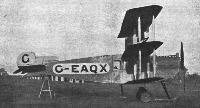
Flight, March 1920
A NEW AVRO TRIPLANE
SPECIAL interest attaches to the latest production of the Avro Co., which has just successfully gone through its trials at Hamble, inasmuch as it revivifies the early activities of this pioneer firm, when Mr. A. V. Roe produced - if not originated - the tractor triplane type of machine. As Mr. A. V. Roe has always been a great believer in the triplane, it is but natural that his firm should have further developed the type.
This new Avro, known as type 547, is seen in the accompanying photograph and scale drawings. It is a purely commercial machine, and is intended for passenger, cargo, or mail work. Accommodation for four passengers, in addition to the pilot, can be arranged for, whilst for cargo or mail work removal of the seats gives a space of 113 cubic feet. In general appearance the machine follows familiar Avro lines, which may, perhaps, be accounted for by the fact that it is built largely from parts of the standard type 504K Avro biplane. Incidentally, this is quite an important feature, not only making for cheap production, but greatly facilitating the maintenance of the machine, as there should be no difficulty in obtaining spares almost anywhere.
The fuselage is on more or less conventional lines, and is extra deep to allow for the provision of a cabin for the passengers. This is located immediately aft of the rear main plane spars, and is fitted up somewhat on the lines of a railway carriage, the seats being arranged for two passengers facing forwards and two rearwards. Access to this cabin is by means of a door in the side of the fuselage, whilst large Triplex windows on either side provide an excellent view for the passengers.
The pilot is located well back along the fuselage, at the rear of the cabin, with his head projecting above the top of the fuselage. From here he has an excellent view in all directions, which, it is claimed, is aided considerably by the triplane arrangement.
A 160 h.p. Beardmore six-cylinder vertical water-cooled engine is installed in the nose of the fuselage, where it drives a tractor screw. A comparatively low petrol consumption is obtained with this engine - in this particular case 9 miles to the gallon with five up and cruising at 80 m.p.h.
All three main planes are of equal span, 37 ft. 3 ins., and chord, 4 ft. 9 3/4 ins. They are set at a dihedral angle of 2 1/2, but have no sweep back or stagger. Ailerons are fitted to all three planes, those on the middle ones being balanced by means of a small surface mounted forward of and above the leading edge of the aileron - a practice employed by the Germans during the War on large multi-engined bombers.
The landing chassis is of the standard Avro type, whilst the rest of the machine appears to be on more or less standard lines, and does not, therefore, call for special comment.
The principal characteristics of the Avro 547 Triplane are as follows:-
Span (all planes) 37 ft. 3 ins.
Chord 4 ft. 9 3/4 ins.
Gap 4 ft. 9 ins.
Dihedral angle 2 1/2
Overall length 29 ft. 10 ins.
Overall height 14 ft. 5 ins.
Area of
main planes (including ailerons) 497 3/4 sq. ft.
ailerons (six) 69 sq. ft.
tail plane 26-5 sq. ft.
elevators 18-5 sq. ft.
fin 7-25 sq. ft.
rudder 9 sq. ft.
Weight fully loaded 3,000 lbs.
Loading
per sq. ft. 6 lbs.
per h.p. 18-8 lbs.
Speed range 45-94 m.p.h.
Cruising speed 80 m.p.h.
Fuel consumption at cruising speed 9 galls./hr.
Climb to
5,000 ft., 15 mins.
1,000 ft., 38 mins.
Описание:
- Flight, March 1920
A NEW AVRO TRIPLANE - Flight, July 1920
The Olympia Aero Show 1920 - Flight, August 1920
THE AIR MINISTRY COMPETITION AT MARTLESHAM
Фотографии
-
История Авиации 2003-03 / С.Корж - Коммерческая авиация /Ретроспектива/ (8)
Регистрационный номер: G-EAQX [3] "Авро-547" - неудачная попытка Эллиота Роу внедрить трипланную схему в коммерческой авиации. Будучи доставлен на корабле в Австралию, самолет развалился при посадке после первого же полета.
-
Flight 1920-03 / Flight
Регистрационный номер: G-EAQX [3] Side view of the Avro Type 547 Triplane, 160 h.p. Beardmore
-
Flight 1920-08 / Flight
Регистрационный номер: G-EAQX [3] The Avro Commercial triplane, type 547A, 240 h.p. Siddeley-Puma engine, for four passengers
-
Flight 1920-07 / Flight
The Avro Commercial Triplane at Olympia: This machine has a very comfortable cabin seating four passengers
-
Flight 1920-10 / Flight
AIR CONFERENCE VISIT TO WADDON: Airco 18, Instone Vickers Vimy-Commercial, Westland Limousine, Avro triplane, and Bristol Coupe
Другие самолёты на фотографии: Bristol Tourer - Великобритания - 1919De Havilland D.H.18 - Великобритания - 1920Vickers Vimy Commercial - Великобритания - 1919Westland Limousine - Великобритания - 1919
-
Flight 1920-11 / Flight
MODERN CABIN MACHINES: The Avro Commercial Triplane.
-
Flight 1920-07 / Flight
View inside the cabin of the Avro triplane: Near the bottom of the dummy door on the port side are seen the hot and cold air regulators, while in the upholstered back-rest is indicated the little hinged flap which allows of communication with the pilot
-
Flight 1920-07 / Flight
The aileron balance on the Avro Triplane
-
Flight 1920-07 / Flight
An Avro interplane strut fitting
-
Flight 1920-03 / Flight
THE AVRO TYPE 547 TRIPLANE: Plan, side and front elevations to scale
- Фотографии











